The Year of Coasts and Waters – my top 20 coastal castles in Scotland
2020 has been designated the Year of Coasts and Waters by VisitScotland. So I have put together some lists of castles for visitors to Scotland to coincide with this theme. This is my first, which is the best 20 castles on the Scottish coasts. I have started in the south-west and worked my way around clockwise.
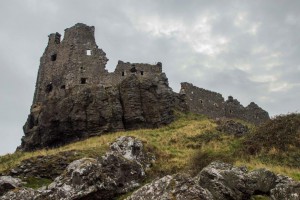 Dunure Castle is free to access and a few miles south of Ayr. It dates in part to the 13th century and was probably a castle of the Earls of Carrick, although by the mid 14th century it was held by the Kennedies. This turbulent family, later Lords Kennedy and Earls of Cassillis, extended the castle repeatedly before its partial destruction in a family feud and eventual dismantling, perhaps by Cromwell’s men. It was never reoccupied.
Dunure Castle is free to access and a few miles south of Ayr. It dates in part to the 13th century and was probably a castle of the Earls of Carrick, although by the mid 14th century it was held by the Kennedies. This turbulent family, later Lords Kennedy and Earls of Cassillis, extended the castle repeatedly before its partial destruction in a family feud and eventual dismantling, perhaps by Cromwell’s men. It was never reoccupied.
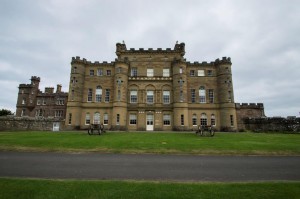 Culzean Castle is another Kennedy castle to the south of Ayr, although little remains to be seen of the old tower of Coif, which was extended into a large L-plan tower in the 16th century and renamed. This in turn was wholly absorbed into the 18th century mansion which is the pride of the National Trust for Scotland today. Beneath the castle is a complex of caves which are said to have led to the old castle. They are – inevitably – blocked off for safety reasons.
Culzean Castle is another Kennedy castle to the south of Ayr, although little remains to be seen of the old tower of Coif, which was extended into a large L-plan tower in the 16th century and renamed. This in turn was wholly absorbed into the 18th century mansion which is the pride of the National Trust for Scotland today. Beneath the castle is a complex of caves which are said to have led to the old castle. They are – inevitably – blocked off for safety reasons.
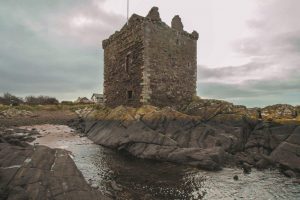 Portencross is a small l-plan tower house built on a rocky promontory near West Kilbride. It was held by the Ross family of Cunningham as the barony of Ardneil before passing to Robert Boyd of Kilmarnock in the 14th century. Who built the first tower is not clear, but it was certainly extended upwards by the Boyds, and called Portencross by 1572. It was abandoned in the 18th century, and has been restored by the Friends of Portencross Castle, who still run the site today.
Portencross is a small l-plan tower house built on a rocky promontory near West Kilbride. It was held by the Ross family of Cunningham as the barony of Ardneil before passing to Robert Boyd of Kilmarnock in the 14th century. Who built the first tower is not clear, but it was certainly extended upwards by the Boyds, and called Portencross by 1572. It was abandoned in the 18th century, and has been restored by the Friends of Portencross Castle, who still run the site today.
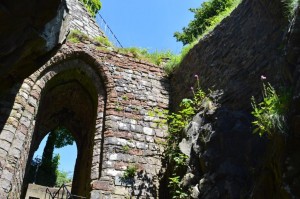 Dumbarton is the oldest continuously fortified site in Scotland. It is a HES property, and the majority of what you can see is post-medieval. The old fort, as the seat of the Kingdom of Strathclyde was attacked repeatedly in the Viking period. In the 11th century Strathclyde was absorbed into the Kingdom of Scotland, and Dumbarton was a royal castle by 1222. It remained an important royal castle and was repeatedly strengthened as artillery developed until abandonment by 1865.
Dumbarton is the oldest continuously fortified site in Scotland. It is a HES property, and the majority of what you can see is post-medieval. The old fort, as the seat of the Kingdom of Strathclyde was attacked repeatedly in the Viking period. In the 11th century Strathclyde was absorbed into the Kingdom of Scotland, and Dumbarton was a royal castle by 1222. It remained an important royal castle and was repeatedly strengthened as artillery developed until abandonment by 1865.
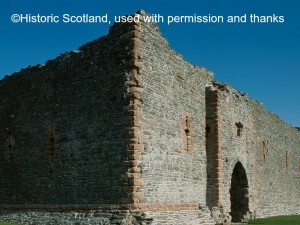 Skipness is a strategically important castle on the west coast of Kintyre, and parts date back to the 13th century, when the MacSweens built a hall and chapel here. This was much strengthened by the Stewart Earl of Menteith, whose family held the castle into the 15th century, when it was granted to the Lords of the Isles briefly. In 1499, Skipness became part of the extensive holdings of the Earl of Argyll, who redesigned the place, converting the hall into a tower house. In was abandoned at the end of the 1`7th century, and today is a HES property.
Skipness is a strategically important castle on the west coast of Kintyre, and parts date back to the 13th century, when the MacSweens built a hall and chapel here. This was much strengthened by the Stewart Earl of Menteith, whose family held the castle into the 15th century, when it was granted to the Lords of the Isles briefly. In 1499, Skipness became part of the extensive holdings of the Earl of Argyll, who redesigned the place, converting the hall into a tower house. In was abandoned at the end of the 1`7th century, and today is a HES property.
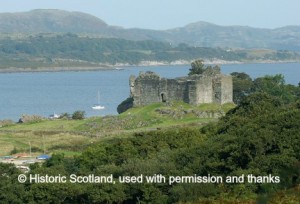 Castle Sween is in many ways a sister castle of Skipness, but is further north and faces westwards. It is a quadrangular walled courtyard dating back to the 13th century, held by the MacSweens, Stewarts, Lords of the Isles and Campbells abandoned in the late 17th century, although the addition of the tower-keep was probably done by the MacMillan family, who held the castle under the Lords of the Isles. It is free to enter, but the caravan park who own the land don’t allow parking to see the castle, meaning there is a bit of a walk.
Castle Sween is in many ways a sister castle of Skipness, but is further north and faces westwards. It is a quadrangular walled courtyard dating back to the 13th century, held by the MacSweens, Stewarts, Lords of the Isles and Campbells abandoned in the late 17th century, although the addition of the tower-keep was probably done by the MacMillan family, who held the castle under the Lords of the Isles. It is free to enter, but the caravan park who own the land don’t allow parking to see the castle, meaning there is a bit of a walk.
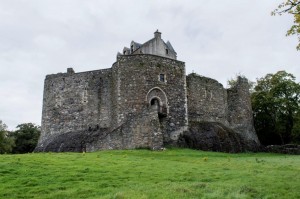 Dunstaffnage is one of the chief castles of the MacDougalls of Lorn, and can be found a few miles north of Oban. It is an irregular courtyard castle occupying a prominent crag, and has three towers, one of which is a later modification containing the main gateway, and has a later house above. It was used by Robert Bruce rather than destroyed, and remained a royal fortress until it passed to the Earl of Argyll in the 15th century. The Campbells added the house c1725 after the castle was burned, destroying the other buildings. It is now managed by HES.
Dunstaffnage is one of the chief castles of the MacDougalls of Lorn, and can be found a few miles north of Oban. It is an irregular courtyard castle occupying a prominent crag, and has three towers, one of which is a later modification containing the main gateway, and has a later house above. It was used by Robert Bruce rather than destroyed, and remained a royal fortress until it passed to the Earl of Argyll in the 15th century. The Campbells added the house c1725 after the castle was burned, destroying the other buildings. It is now managed by HES.
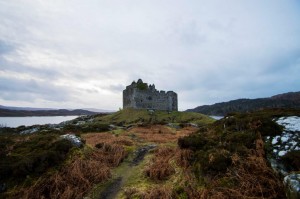 Castle Tioram is perhaps better known for its more recent history than its medieval history. It’s a privately owned castle on a tidal island on the west coast, and is fenced off for safety reasons. It was probably built in the 13th century by the MacRuari family and remained a Macdonald property until it was abandoned in the 17th century. It was converted to a garrison in the Jacobite period but burned and never repaired. More recently there has been a very heated debate about its possible restoration.
Castle Tioram is perhaps better known for its more recent history than its medieval history. It’s a privately owned castle on a tidal island on the west coast, and is fenced off for safety reasons. It was probably built in the 13th century by the MacRuari family and remained a Macdonald property until it was abandoned in the 17th century. It was converted to a garrison in the Jacobite period but burned and never repaired. More recently there has been a very heated debate about its possible restoration.
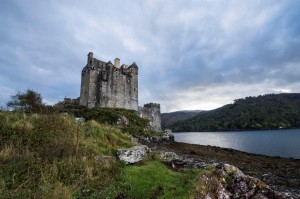 Eilean Donan Castle is Scotlands chocolate box castle, on the west coast near Skye. Dating back to the 13th century when it was established as a royal castle, it was held by the Mackenzies as crown agents in the 14th century and destroyed, to be rebuilt on a smaller scale in the latter 15th century, when the keep was built. Granted wholly to the Mackenzies at some point, later constables were the MacRaes. It was upgraded in the 17th century and blown up in 1719 before being wholly restored in the early 20th century by the MacRae family.
Eilean Donan Castle is Scotlands chocolate box castle, on the west coast near Skye. Dating back to the 13th century when it was established as a royal castle, it was held by the Mackenzies as crown agents in the 14th century and destroyed, to be rebuilt on a smaller scale in the latter 15th century, when the keep was built. Granted wholly to the Mackenzies at some point, later constables were the MacRaes. It was upgraded in the 17th century and blown up in 1719 before being wholly restored in the early 20th century by the MacRae family.
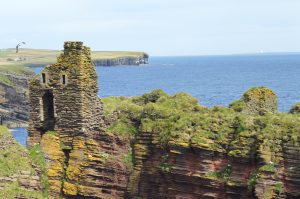 Bucholly Castle is the most picturesque of the promontory castles of Caithness. Built by the Mowats in the 15th century on the site of an earlier fort, it was earlier called Freswick Castle. The history of Bucholly is largely unknown, but it was probably abandoned in the 17th century – perhaps used as a quarry to supply materials when the lands passed to the Sinclairs of nearby Burnside of Freswick, and the tower there was massively extended. It is not accessible save to the foolhardy as the site is very dangerous.
Bucholly Castle is the most picturesque of the promontory castles of Caithness. Built by the Mowats in the 15th century on the site of an earlier fort, it was earlier called Freswick Castle. The history of Bucholly is largely unknown, but it was probably abandoned in the 17th century – perhaps used as a quarry to supply materials when the lands passed to the Sinclairs of nearby Burnside of Freswick, and the tower there was massively extended. It is not accessible save to the foolhardy as the site is very dangerous.
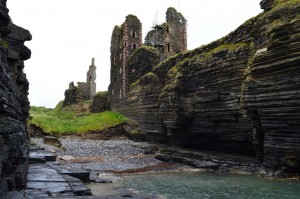 Castle Sinclair is a fantastic castle built on a promontory near Wick. The original 15th century tower and courtyard was called Castle Girnigoe, and is not currently accessible to the public. It was extended in the latter 15th and 16th centuries, and became the most lavish palace in the north of Scotland, and renamed Castle Sinclair. It was garrisoned by English troops in the 17th century and was granted to the The Sinclairs blasted their seat with cannon in 1690 to ensure the Campbells would never occupy it. Today it is being restored by the Clan Sinclair Trust.
Castle Sinclair is a fantastic castle built on a promontory near Wick. The original 15th century tower and courtyard was called Castle Girnigoe, and is not currently accessible to the public. It was extended in the latter 15th and 16th centuries, and became the most lavish palace in the north of Scotland, and renamed Castle Sinclair. It was garrisoned by English troops in the 17th century and was granted to the The Sinclairs blasted their seat with cannon in 1690 to ensure the Campbells would never occupy it. Today it is being restored by the Clan Sinclair Trust.
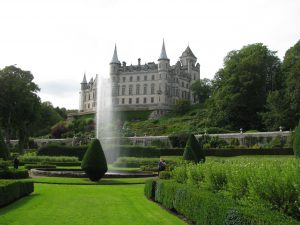 Dunrobin Castle is the seat of the Dukes of Sutherland, who have had a castle at this site since perhaps the 13th century. However the oldest part of the castle is a square tower which is all but hidden from view, and dates to the latter 14th or early 15th century. Extensions were added in the 16th and 17th centuries before the castle was completely remodelled in romantic chateau style. Accompanied by extensive and beautiful gardens, it is justifiably one of the most famous in Scotland.
Dunrobin Castle is the seat of the Dukes of Sutherland, who have had a castle at this site since perhaps the 13th century. However the oldest part of the castle is a square tower which is all but hidden from view, and dates to the latter 14th or early 15th century. Extensions were added in the 16th and 17th centuries before the castle was completely remodelled in romantic chateau style. Accompanied by extensive and beautiful gardens, it is justifiably one of the most famous in Scotland.
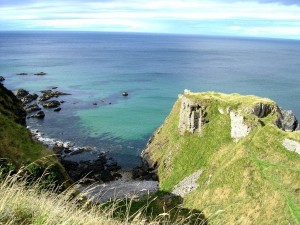 Findlater Castle on the Moray coast was occupied as a defensive site in the 13th century as a royal castle, but the principal remains that can be seen on the clifftop today are the ruins of the 15th to 16th century seat of the Sinclairs and Ogilvies. It was abandoned by the family in the late 16th century after an inheritance dispute with the Gordons, who refused to let Queen Mary into the castle. Traditionally it was demolished c1600 when Cullen House was built, but it is more likely that weather played a major part in its collapse. The site is dangerous and should be approached with caution.
Findlater Castle on the Moray coast was occupied as a defensive site in the 13th century as a royal castle, but the principal remains that can be seen on the clifftop today are the ruins of the 15th to 16th century seat of the Sinclairs and Ogilvies. It was abandoned by the family in the late 16th century after an inheritance dispute with the Gordons, who refused to let Queen Mary into the castle. Traditionally it was demolished c1600 when Cullen House was built, but it is more likely that weather played a major part in its collapse. The site is dangerous and should be approached with caution.
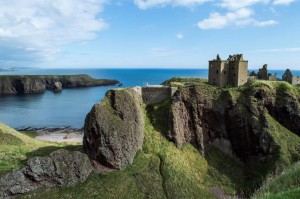 Dunottar Castle south of Aberdeen was originally the site of a monastery and chapel, and Sir William Keith who first defended the site in the 14th century was excommunicated for building on holy ground! Having satisfied the church, the Keiths built a massive tower house on the promontory, which was extended repeatedly, and used as a hiding place for the Scottish regalia for a while. Privately owned, it is open to the public, and a very popular site for visitors.
Dunottar Castle south of Aberdeen was originally the site of a monastery and chapel, and Sir William Keith who first defended the site in the 14th century was excommunicated for building on holy ground! Having satisfied the church, the Keiths built a massive tower house on the promontory, which was extended repeatedly, and used as a hiding place for the Scottish regalia for a while. Privately owned, it is open to the public, and a very popular site for visitors.
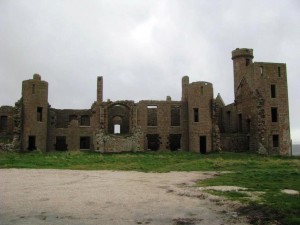 Slains Castle is a massive complex with a remodelled 17th century courtyard palace at its core. Within one of the towers is the vault of the original tower house of the Hays, Bowness. When Old Slains was blown up by King James VI, the new palace was built and renamed in its memory. It was extended in the 17th and 18th centuries, and then completely remodelled and refaced in granite in the 19th century. Said to have been an inspiration for Bram Stoker, it was a lively occupied family home when he stayed nearby in 1895. The place was sold in 1916 and immediately deroofed for tax reasons.
Slains Castle is a massive complex with a remodelled 17th century courtyard palace at its core. Within one of the towers is the vault of the original tower house of the Hays, Bowness. When Old Slains was blown up by King James VI, the new palace was built and renamed in its memory. It was extended in the 17th and 18th centuries, and then completely remodelled and refaced in granite in the 19th century. Said to have been an inspiration for Bram Stoker, it was a lively occupied family home when he stayed nearby in 1895. The place was sold in 1916 and immediately deroofed for tax reasons.
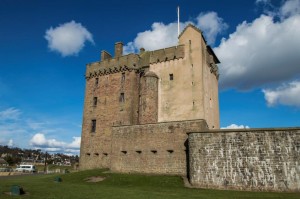 Broughty Castle is an impressive tower to the east of Dundee built in the late 15th century by the Gray family. Dominating the Firth of Tay and approach to Dundee, it was handed to the English by the Grays, and then sacked by the Scots in the mid 16th century to prevent the English from continuing to hold it. It was purchased by the War Office in 1851, which refurbished and extended it during their 100 years in occupation. Today it is operated as a museum.
Broughty Castle is an impressive tower to the east of Dundee built in the late 15th century by the Gray family. Dominating the Firth of Tay and approach to Dundee, it was handed to the English by the Grays, and then sacked by the Scots in the mid 16th century to prevent the English from continuing to hold it. It was purchased by the War Office in 1851, which refurbished and extended it during their 100 years in occupation. Today it is operated as a museum.
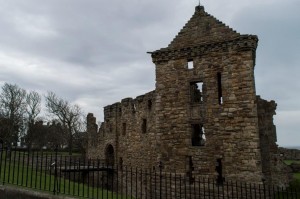 St Andrews Castle at the eastern tip of Fife was the castle of the Bishops of St Andrews from at least 1200, although that castle was levelled during the Wars of Independence. What can be seen today is the late 15th century castle of Bishop Trail, and the subsequent alterations of the 15th and 16th centuries. Partially eroded away by the sea, the castle was in ruins in the Civil War period and used as a quarry. Erosion continued until 1801, when a sea wall was built, and today the castle is maintained by HES.
St Andrews Castle at the eastern tip of Fife was the castle of the Bishops of St Andrews from at least 1200, although that castle was levelled during the Wars of Independence. What can be seen today is the late 15th century castle of Bishop Trail, and the subsequent alterations of the 15th and 16th centuries. Partially eroded away by the sea, the castle was in ruins in the Civil War period and used as a quarry. Erosion continued until 1801, when a sea wall was built, and today the castle is maintained by HES.
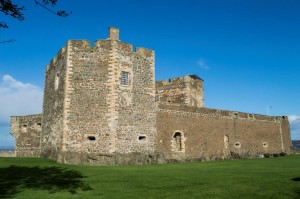 Blackness Castle on the southern coast of the Firth of Forth was founded in the mid 15th century by the Crichton family, and then claimed by King James II. It was strengthened in the 16th and 17th century as an important coastal artillery fort, but still fell to Cromwells guns in 1651. It was repaired and remained in use into the 18th century as a prison, and as a garrison into the late 19th century. Briefly used in each of the World Wars, it is now maintained by HES and is open to the public.
Blackness Castle on the southern coast of the Firth of Forth was founded in the mid 15th century by the Crichton family, and then claimed by King James II. It was strengthened in the 16th and 17th century as an important coastal artillery fort, but still fell to Cromwells guns in 1651. It was repaired and remained in use into the 18th century as a prison, and as a garrison into the late 19th century. Briefly used in each of the World Wars, it is now maintained by HES and is open to the public.
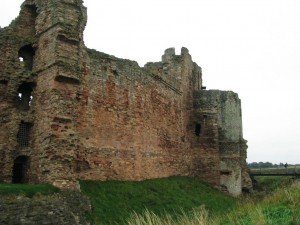 Tantallon Castle on the East Lothian coast was the seat of the Red Douglases, Earls of Angus. The defence was principally the massive curtain wall and towers, with a ditch in front, and the residential buildings behind. Founded in the 14th century, it was repeatedly attacked by the Scottish Crown during their disputes with the Douglas family, and eventually fell out of favour as a residence in the late 16th century. It was attacked and the walls breached by English artillery in the Civil War and never repaired; today it is a very popular HES attraction.
Tantallon Castle on the East Lothian coast was the seat of the Red Douglases, Earls of Angus. The defence was principally the massive curtain wall and towers, with a ditch in front, and the residential buildings behind. Founded in the 14th century, it was repeatedly attacked by the Scottish Crown during their disputes with the Douglas family, and eventually fell out of favour as a residence in the late 16th century. It was attacked and the walls breached by English artillery in the Civil War and never repaired; today it is a very popular HES attraction.
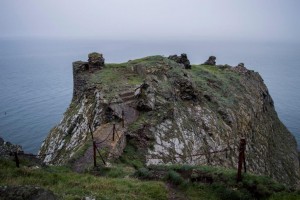 Fast Castle completes our circuit of Scottish coastal castles. Scant ruins remain on the headland of the castle of the Dunbars and Homes, which dates to at least the 14th century, guarding the coastal invasion route from its remote location, the precarious bridge today is a reminder of how impregnable these promontory castles could be. It was destroyed and rebuilt in the early 16th century by the Lords Home, repeatedly attacked in the Rough Wooing, and was probably maintained into the mid 17th century after which nothing more is heard of it. Pedestrian access is possible at all times – but the path is wet and can be treacherous.
Fast Castle completes our circuit of Scottish coastal castles. Scant ruins remain on the headland of the castle of the Dunbars and Homes, which dates to at least the 14th century, guarding the coastal invasion route from its remote location, the precarious bridge today is a reminder of how impregnable these promontory castles could be. It was destroyed and rebuilt in the early 16th century by the Lords Home, repeatedly attacked in the Rough Wooing, and was probably maintained into the mid 17th century after which nothing more is heard of it. Pedestrian access is possible at all times – but the path is wet and can be treacherous.
I hope you have enjoyed our little trip around the castles of the Scottish coast. Next time, we’ll look at castles by Scotland’s wonderful rivers!
